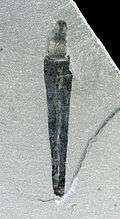Selkirkia
| Selkirkia Temporal range: Cambrian Stage 3–Middle Cambrian | |
|---|---|
 | |
| Selkirkia columbia fossil from the Burgess Shale. From Smith et al. (2015)[1] | |
 | |
| Restoration of Selkirkia columbia | |
| Scientific classification | |
| Kingdom: | Animalia |
| Stem-group: | Priapulida (?) |
| Class: | †Archaeopriapulida |
| Family: | †Selkirkiidae Conway Morris, 1977[2] |
| Genus: | †Selkirkia Walcott, 1911 |
| Species | |
| |
Selkirkia is a genus of predatory,[3] tubicolous priapulid worm known from the Middle Cambrian Burgess Shale, Ogygopsis Shale and Puncoviscana Formation.[4] 142 specimens of Selkirkia are known from the Greater Phyllopod bed, where they comprise 0.27% of the community.[5] In the Burgess Shale, 20% of the tapering, organic-walled tubes are preserved with the worm inside them, whereas the other 80% are empty (or sometimes occupied by one or more small agnostid trilobites).[3] Whilst alive, the tubes were probably vertical, whereas trilobite-occupied tubes are horizontal.[3]
Morphology
Selkirkia had a body divisible into a proboscis towards the anterior of a trunk enclosed by a tube. The proboscis would have been partially invertable and was armed with several spinules and spines, decreasing size distally overall. It was controlled by at least two sets of anterior retractor muscles. Immediately behind the proboscis was the trunk, smooth for the most part but lined with papillae towards the anterior. Surrounding the trunk was the tube, which way very finely annulated (4 annulations per 0.1 millimeters).
History
Members Cambrorhytium were originally described as Selkirkia before their identification as a separate genus.[6]
External links
- "Selkirkia columbia". Burgess Shale Fossil Gallery. Virtual Museum of Canada. 2011.
References
- ↑ Smith, M. R.; Harvey, T. H. P.; Butterfield, N. J. (2015). "The macro- and microfossil record of the Cambrian priapulid Ottoia". Palaeontology: n/a. doi:10.1111/pala.12168.
- ↑ Conway Morris, S (1977). "Fossil priapulid worms". Special papers in Palaeontology. 20.
- 1 2 3 Chatterton, B. D. E.; Collins, D. H.; Ludvigsen, R. (2003). "Cryptic behaviour in trilobites: Cambrian and Silurian examples from Canada, and other related occurrences". In Lane, P. D; Siveter, D. J; Fortey, R. A. Trilobites and Their Relatives. Special Papers in Palaeontology. 70. The Palaeontological Association. pp. 157–173. ISBN 9780901702814.
- ↑ Aceñolaza, Florencio; Guillermo, Aceñolaza (2005). "La formación Puncoviscana y unidades estratigráficas vinculadas en el neoproterozoico - Cámbrico temprano del noroeste argentino" (PDF). Latin American Journal of Sedimentology and Basin Analysis (in Spanish). Asociación Argentina de Sedimentología. 12 (2): 65–87. Retrieved 7 December 2015.
- ↑ Caron, Jean-Bernard; Jackson, Donald A. (October 2006). "Taphonomy of the Greater Phyllopod Bed community, Burgess Shale". PALAIOS. 21 (5): 451–65. doi:10.2110/palo.2003.P05-070R. JSTOR 20173022.
- ↑ See Cambrorhytium.